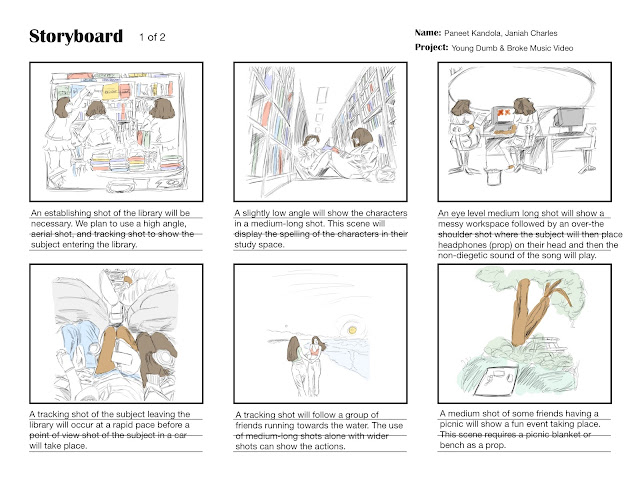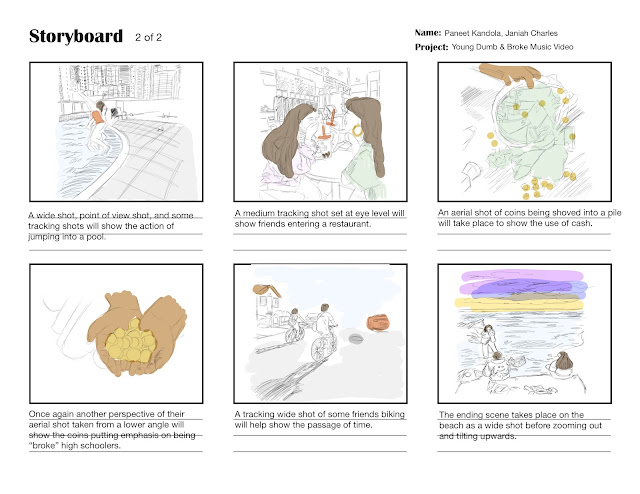Storyboard Blog - The Breakdown
An Overview
Scene 1 will begin with an establishing shot of the main quarters of the library with an elevated (high) angle giving the effect of an aerial shot. Then the subject will walk into the scene, book in hand, with a stressed appearance. Next, a tracking shot will be used to demonstrate the student looking for a study space before settling down in the corner of the library. In the scene, some books and a backpack are vital props. As for the auditory enhancements, only diegetic sound will be used; the song will not have started yet.
Scene 2 will be in the corner that was discovered in the scene. A slighter lower angle will be used and the subject will be met with other characters. At this point, the “student” is trying to study. She will be reading a book and annotating in a distressed manner. Only diegetic noise will be used in these clips.
Scene 3 is where the non-diegetic noise will be introduced. A clip of students will be taken from eye level with their backs facing the camera. In this medium-long shot, the students will be working on computers. The camera will shift focus to one student before switching to an over-the-shoulder shot. But, this shot will display the screen where a student repetitively fails an exam. Clear frustration is painted on the subject's face so they turn to their headphones. They will place the headphones on their head before the music will play and they click to play the “Young Dumb & Broke” song.
Scene 4 is about the passage of time. The students working will rush out of the library and smush into a car driving to the beach.
**From this point onwards the clips used will be “more natural” as if they are filming them themselves (this is a popular editing technique we have seen but were primarily inspired by the music video of Good Days by SZA and With You by AP Dhillion). Considering this the clips will primarily be at eye level but a few point-of-view shots will be used and the camera will be moving with no still shots. The idea behind this technique is to show the fast movements of having fun flashing through. So the scenes will skip back and forth from the same location but will act as a cohesive unit. Additionally, the characters will be acting very happy and enjoying the moment.
Scene 5 will be a tracking shot of a group of friends running towards the water at a beach. They will splash around the water, happily dancing by the sea with a “freeing” expression on their face. A wide shot will be used to show the change in environments and make a stark difference from the library.
Scene 6 will be another wide shot compiled by a few mediums and tracking shots of movements will be used to display a picnic that the “friends” are having. The necessary props to display a picnic will be needed like a blanket and some food.
Scene 7 is another core memory. This shot will be filmed at a pool. The individuals will jump into a pool, laughing together. A wide shot will be used along with point-of-view shots.
Scene 8 is taking place in a restaurant of some sort. This is where the idea of being “broke” is introduced.
Scene 9 is when a group of friends are trying to pay for their subjectively “cheap” meal so they use coins to pay. They all have a hand full of coins and cash crumpled up to pay.
Scene 10 shows the mound of cash used which is comparatively different from the rest of the people in the restaurant because they are using credit cards.
Scene 11 resumes back to the “fun” activities where the characters will be biking away which also helps demonstrate how they are “young”. Given the connotation that young people bike.
Scene 12 ends on the beach which creates a complete “day” since the first “fun” scene was at the beach. Here the characters will be enjoying each other's company singing to the song playing on the radio. Before a wide shot of their back is filmed and then zooms out to show the surroundings fuller and a tilt upwards where the video will end.
Note: Some of these things will be dependent on the conditions of the location so the plan must remain tentative. Here are some adaptations we will make if necessary:
Scene 3 - If the over-the-shoulder shot of a student failing a test digitally doesn't work then we still use an over-the-shoulder shot but the student will be writing before getting frustrated and crumpling up the paper.
Scene 3 - If the over-the-shoulder shot doesn't come out accordingly we will use a pan of the scene in the form of a point-of-view shot showing a messy desk to replicate the same frustration.
Scene 4 - If we are not able to use the car of our parents we will either use bikes to show this passage of time or we will use an extreme close-up shot of the eye before dissolving into a white screen and then fading out into the scenes of the characters having “fun”
Scene 8 - We may not be able to film in certain establishments so we haven't set a place to film. We hope to use a place on the beach or in one of the locations we are already filming but if we are unable to then we will go to a fast food place near us.
General - If some of our friends are unable to come to film we will film the opening scenes with just one main character and then as the “fun” scenes approach the introduction for more characters will ensue at the beach and they will remain for the duration of the song.
General - We want the “fun” clips to be as raw as possible. Considering it will be a group of teenagers filming and not professional actors the best way to do this is to enjoy our time ourselves and film secondary. In short Janiah and I have decided to use this music video to narrate the daily lives of many students through our personal experiences.
- General - If any of the pre-planned “fun” scenes are unable to be filmed for any circumstance another event will take place. For example, if we are unable to film the picnic scene (6) then we will use the carand insert a video of us “driving” (we will not be driving, the car will be stationary, and make sure our safety is the utmost priority when filming) and singing the lyrics of the song on the radio.
- General - Considering the 1:10-1:15 time frame for this video some of the “fun” clips will be removed and added as needed to make this time.
This is so much to take in but I am sure the production process will be able to make these plans come to life. I am super passionate about this project since the song “Young Dumb & Broke” is about enjoying where you are in life at that moment. I struggle with this so I hope this project will encourage me to take a step back and enjoy the small mementos that make up being a teenager. Hope you enjoyed hearing about my plans!



Comments
Post a Comment